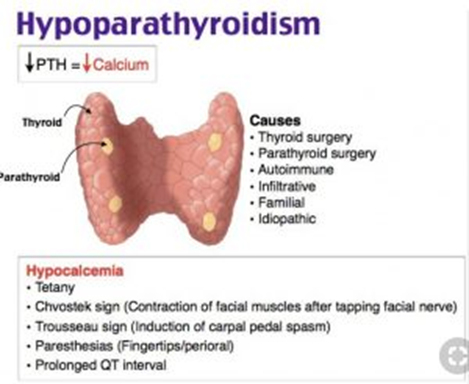A nurse is instructing a client with newly diagnosed hypo-parathyroidism about this disorder. The nurse explains to the patient that the physician has prescribed daily supplements of calcium and vitamin D. Which education by the nurse is appropriate for this patient?
"The parathyroid has no effect on calcium levels in the body, this will just help prevent osteoporosis"
"The reason you have hypo-parathyroidism is because you were diagnosed with hypothyroidism, and when the thyroid doesn't work, neither does the parathyroid, so you need these supplements."
"A decrease in parathyroid hormone causes low calcium levels, so your body to break down bones in order to maintain normal calcium levels, and this will prevent that from happening."
"An increase in parathyroid hormone causes your body to move calcium into the cells to reduce blood calcium levels, so you have to replace the levels in the blood."
The Correct Answer is C
A. "The parathyroid has no effect on calcium levels in the body; this will just help prevent osteoporosis":
Explanation: This statement is incorrect. The parathyroid gland plays a crucial role in calcium homeostasis. Hypoparathyroidism, characterized by decreased parathyroid hormone (PTH) production, leads to low blood calcium levels, not high levels.
B. "The reason you have hypoparathyroidism is that you were diagnosed with hypothyroidism, and when the thyroid doesn't work, neither does the parathyroid, so you need these supplements."
Explanation: This statement is incorrect. The parathyroid and thyroid are separate glands with distinct functions. Hypoparathyroidism is not a result of hypothyroidism.
C. "A decrease in parathyroid hormone causes low calcium levels, so your body to break down bones to maintain normal calcium levels, and this will prevent that from happening."
Explanation: This is the correct statement. Hypoparathyroidism leads to a decrease in PTH, resulting in low blood calcium levels. Without sufficient PTH, the body may resort to breaking down bones to maintain calcium levels.
D. "An increase in parathyroid hormone causes your body to move calcium into the cells to reduce blood calcium levels, so you have to replace the levels in the blood."
Explanation: This statement is incorrect. An increase in parathyroid hormone (PTH) typically leads to increased blood calcium levels by promoting the release of calcium from bones and reducing calcium excretion by the kidneys. This describes hyperparathyroidism, not hypoparathyroidism.

Nursing Test Bank
Naxlex Comprehensive Predictor Exams
Related Questions
Correct Answer is A
Explanation
A. "If a vial of insulin will be used up within 21 days, it may be kept at room temperature."
This statement suggests a duration of up to 21 days for room temperature storage after the vial is in use. However, most insulins can typically be stored at room temperature for up to 28 days after initial use. This recommendation might be more conservative than necessary for many types of insulin.
B. "If a vial of insulin will be used up within 2 weeks, it may be kept at room temperature."
This choice suggests a timeframe of 14 days for room temperature storage after opening the vial. However, for many insulins, the recommended duration for room temperature storage after opening is up to 28 days.
C. "If you are going to use up the vial within 1 month, it can be kept at room temperature."
This option extends the timeframe to 1 month for room temperature storage after the vial is in use. However, the generally recommended duration for many insulins is up to 28 days after opening.
D. "If a vial of insulin will be used up within 1 week, it may be kept at room temperature."
This choice suggests a very short duration of 7 days for room temperature storage after opening the vial. Most insulins can typically be stored at room temperature for a longer duration after initial use.
Correct Answer is C
Explanation
A. 15 to 20 g of a fast-acting carbohydrate such as orange juice:
This is a standard and initial treatment for hypoglycemia. Fast-acting carbohydrates, like orange juice or glucose tablets, can quickly raise blood sugar levels. However, in the scenario described, the client is still conscious, and glucagon may be a more appropriate choice.
B. I.V. bolus of dextrose 50%:
Intravenous (IV) dextrose is a more aggressive intervention and is typically reserved for severe cases of hypoglycemia or for unconscious patients. It is not the first-line treatment for conscious patients.
C. I.M. or subcutaneous glucagon:
Glucagon is a hormone that raises blood sugar levels by promoting the conversion of stored glycogen in the liver to glucose. It is administered either intramuscularly (I.M.) or subcutaneously. In a conscious patient with hypoglycemia who cannot take oral carbohydrates, glucagon can be an effective and rapid way to raise blood sugar levels.
D. 10 U of fast-acting insulin:
Administering more insulin in a situation of hypoglycemia would worsen the condition. The goal in hypoglycemia is to raise blood sugar, and giving more insulin would have the opposite effect.
Whether you are a student looking to ace your exams or a practicing nurse seeking to enhance your expertise , our nursing education contents will empower you with the confidence and competence to make a difference in the lives of patients and become a respected leader in the healthcare field.
Visit Naxlex, invest in your future and unlock endless possibilities with our unparalleled nursing education contents today
Report Wrong Answer on the Current Question
Do you disagree with the answer? If yes, what is your expected answer? Explain.
Kindly be descriptive with the issue you are facing.
